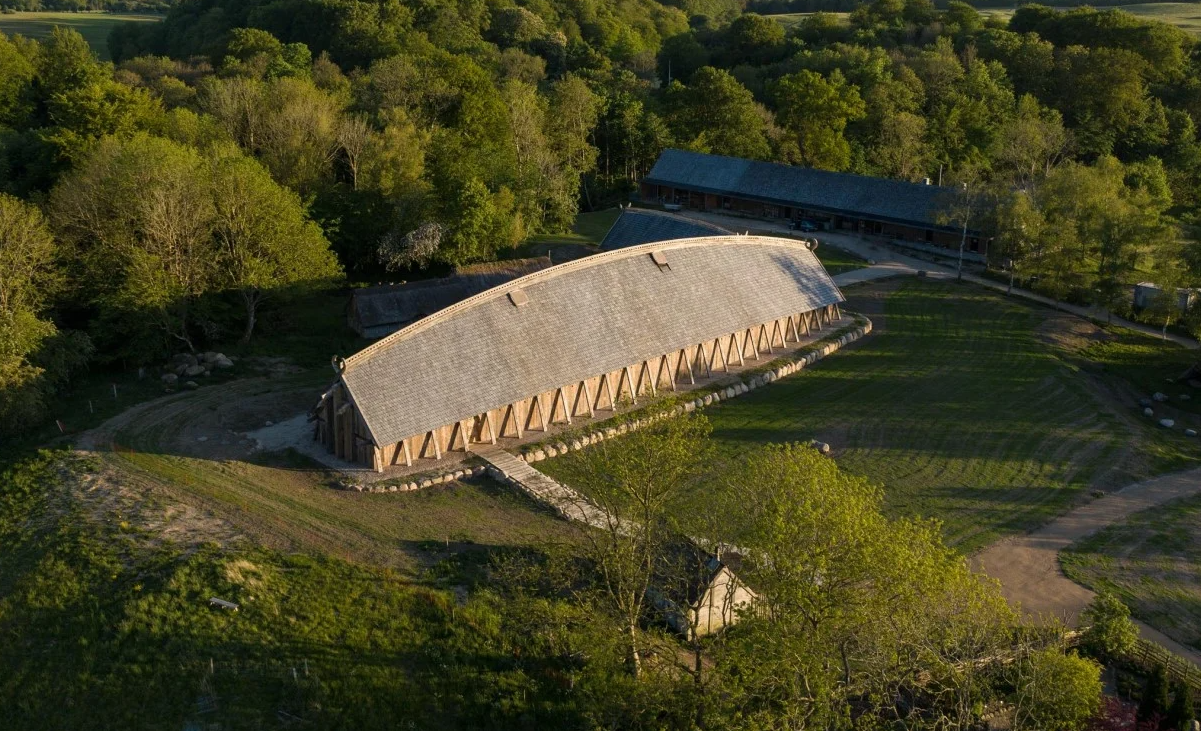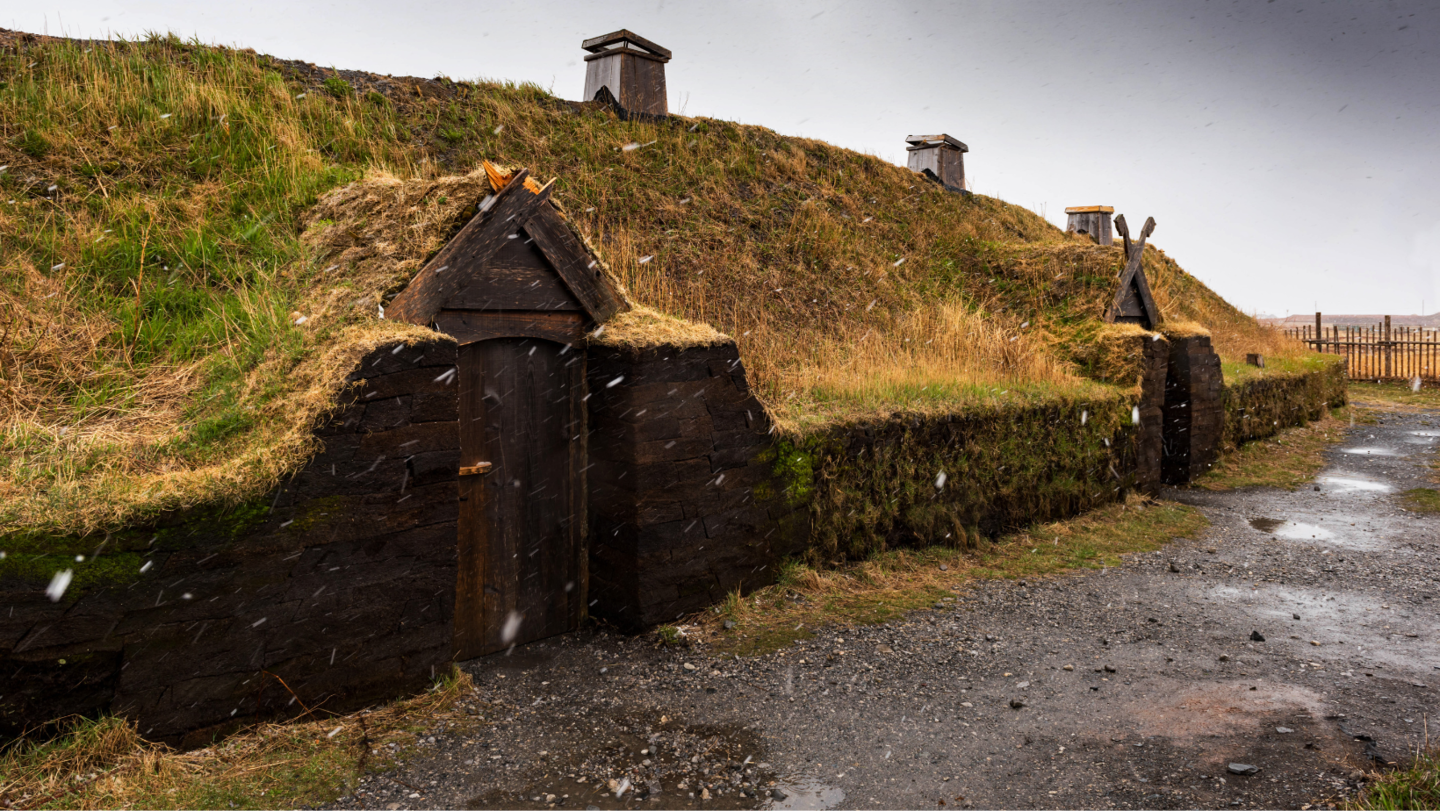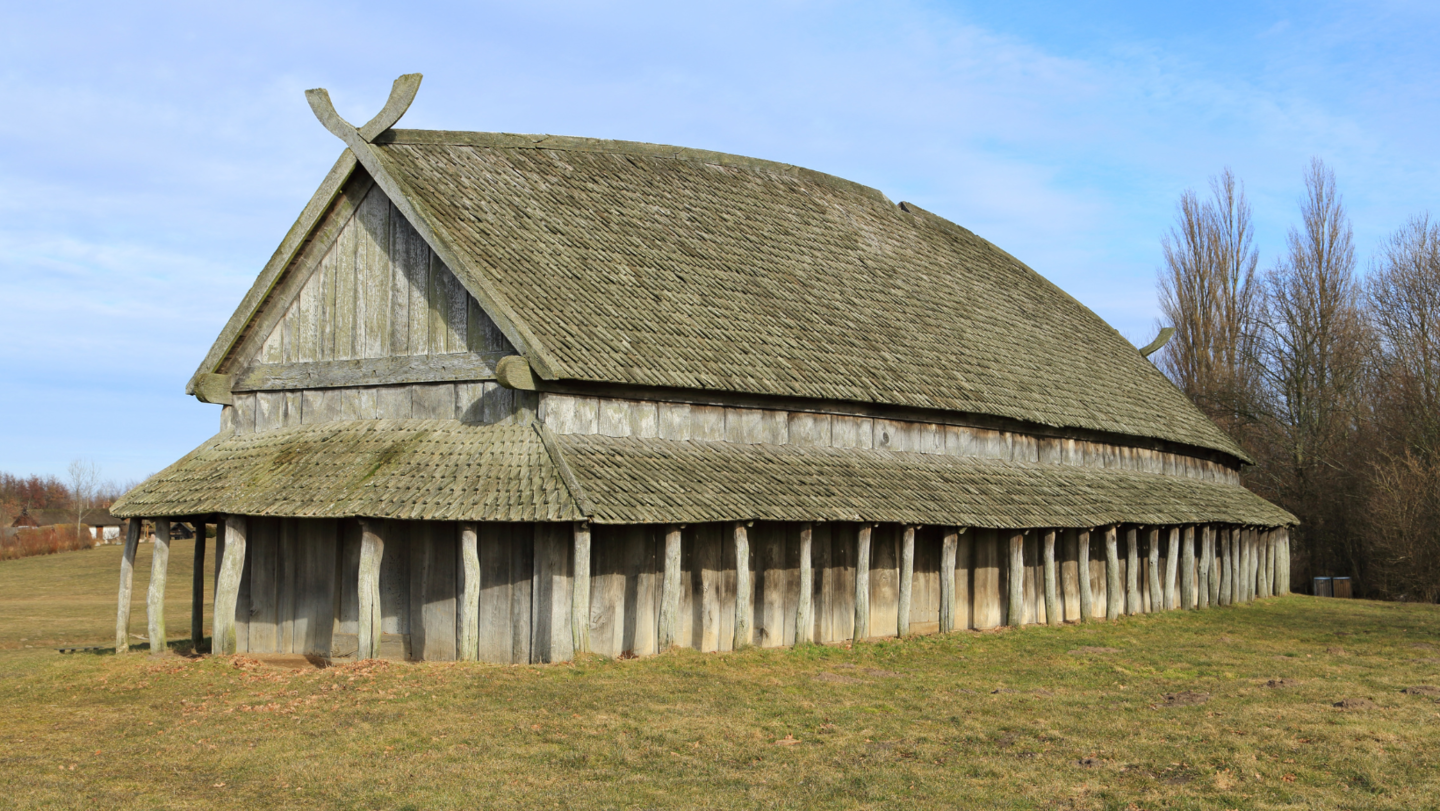Ever wonder what life was like in the age of Vikings? Imagine stepping into a Viking longhouse, the heart and hearth of early Norwegian society. It’s more than just a shelter – it’s an intricate community bustling with daily chores, hearty meals, and stories shared around fires.
This isn’t your typical history lesson. No fluff or dry dates here! We’re going to dive deep into Norse sagas, exploring how these architectural marvels shaped Viking culture from within their timber frames and turf walls.
From learning about its unique construction to understanding living arrangements inside these communal dwellings, you’ll gain valuable insights that paint a vivid picture of this fascinating era. And who knows? With Viking Longhouses, you might even pick up some ancient survival tips for those harsh winter months!
Life is a journey through time, waiting for us to grab hold. So, let’s take the chance before it sails away.
Table Of Contents:
- Viking Longhouse – An Insight into the Norse Sagas and Viking Life
- Design and Construction of a Typical Viking Longhouse
- Layout and Features of Viking Longhouses
- Reconstructed Viking Longhouses Today
- Daily Life in a Viking Longhouse
- Comparison of Viking Longhouses in Different Regions
- FAQs in Relation to Viking Longhouse
- Conclusion
Viking Longhouse – An Insight into the Norse Sagas and Viking Life

At the heart of every Viking village, there was a longhouse, an iconic symbol of how Vikings lived. These structures were not just houses but played a pivotal role in everyday life and culture during the Viking Age.
The Role of Longhouses in Everyday Life
In rural villages where most Vikings resided, small farms dominated the landscape with longhouses as their centerpiece. This setup is well depicted in Norse sagas, providing rich insights into Viking house designs and lifestyles.
A typical Viking longhouse accommodated more than family living; it also housed livestock during harsh winters to keep them warm while simultaneously providing heat for inhabitants. Moreover, these buildings functioned as community centers hosting feasts or important meetings on behalf of chieftains.
As per early Norwegian history accounts, daily chores revolved around sustaining livelihoods through farming or fishing activities centered around these homes. From sunrise to sunset, men worked outdoors while women took care of household tasks such as cooking meals over open hearths and crafting textiles from woolen yarn spun by hand.
Vikings’ Engineering Marvel: The Design & Construction Of A Typical Longhouse
The ingenious design features incorporated within each Viking house demonstrate a keen understanding by our ancient predecessors about utilizing available resources effectively. Timber frames served as structural skeletons for these buildings, with turf-covered roofs ensuring thermal insulation against frigid Nordic weather conditions.
Stone hearths formed central corridors, providing warmth and serving cooking purposes. In contrast, wooden planks fashioned benches were used for seating arrangements, converting conveniently into sleeping areas when bed clothes fell at night-time.
Each Viking house was essentially a living testament to the age-old adage ‘necessity is the mother of invention.’ For instance, due to the scarce availability of candles, considered luxury items back then, Vikings constantly innovated by using animal fats or even cod liver oil and whale oil as alternative light sources.
The Legacy Continues: Reconstructed Longhouses Today
The Lofotr Viking Museum paints a vivid picture. They give us a detailed look at how life might have been in these historical dwellings, immersing us further into the fascinating world of our ancestors.
Key Takeaway:
Delving into Viking life, the longhouse was more than a home—it was central to everyday existence. Housing families and livestock alike, these marvels of engineering also served as community hubs for feasts and meetings. From ingenious design features like turf-covered roofs to resourceful lighting solutions, each element reflected the Vikings’ practicality in action.
Design and Construction of a Typical Viking Longhouse

Viking longhouses, also known as turf houses, are an engineering marvel from the past. Built with ingenuity using locally available resources, these structures served as multifunctional homes for families in early Norwegian history.
Materials Used for Construction
The primary materials used were wooden planks and turf. Walls were often made from clay or wooden planks, while roofs featured thatched straw or turf to ensure insulation against harsh winters. Combining these materials helped maintain a comfortable temperature inside the longhouse year-round.
Timber frames provided structural support, typically sourced from sturdy local trees such as oak. Stone hearths became central gathering points within these homes where food was prepared, and stories shared on cold nights around warming fires.
Structural Design Elements
A typical Viking longhouse had several distinctive design features contributing to its practicality and durability. One prominent feature was smoke holes strategically placed along the roofline to allow smoke out without letting too much rain in—a clear testament to Viking engineering skills.
Beneath this well-thought-out roof lay a corridor running down the center of the house—the heart of all activity within it—providing space for cooking over open fires, crafting tools, weaving textiles, or hosting communal gatherings.
Surrounding this corridor were supporting columns upholding strong timber beams holding up both walls and roofs. This simple yet effective construction method ensured stability even under heavy snow loads during winter months. As you can see so far, a lot of thought went into the construction and design of these Viking longhouses.
It’s interesting to note that although windows were rare, light entered through vents or gaps in the thatching. They may not have had electric lighting, but Vikings sure knew how to use natural resources to their advantage.
In essence, understanding Viking longhouse architecture isn’t just about examining an ancient housing type—it’s a window into daily life during the Viking age. It speaks volumes about their resourcefulness and adaptability—traits as enduring as the structures they built centuries ago.
Key Takeaway:
Even without windows, these Viking longhouses demonstrate the ingenuity of early Norse society. They utilized what was available and transformed it into a sturdy, functional home that catered to their needs despite challenging weather conditions.
Layout and Features of Viking Longhouses

The layout and features of a Viking longhouse were meticulously planned to accommodate an extended family. The main building, the heart of people living together in harmony, had unique elements that provided comfort during harsh winters.
Living Arrangements
A typical longhouse was divided into three sections, with a central corridor acting as the spine. This structure not only supported movement but also hosted fires for cooking and heating. It’s fascinating how such simple architecture could provide warmth to all inhabitants equally.
Besides heat distribution, these corridors served another essential function – textile production. Yep, you heard it right; Vikings knew their fashion game well before modern times.
Vikings made clever use of space within their homes. Wooden benches lined along walls offered seating during daytime activities and transformed into cozy beds at nightfall.
Animal hides draped over these benches, serving multiple purposes – providing extra warmth against cold drafts seeping through wooden planks or turf walls, adding softness for comfortable sleeping arrangements, and even offering privacy in some cases.
This multifunctional approach wasn’t exclusive to furniture alone; wealthier families often incorporated more extravagant features like stone hearths or smoke holes for added convenience. Now, isn’t that an early lesson on interior design?
Dining Setup: More than Just Eating Together
Moving further down, our tour inside a Norse home reveals interesting insights about dining setups, too. For Vikings, sharing meals was less about food consumption itself but more about communal bonding—imagine big Thanksgiving dinners every day.
Tables would be arranged around the central fire, which not only cooked their food but also provided light and warmth. No wonder they were such hardy folks; imagine swapping stories with your kinfolk under a roof lit by flickering flames.
The Ingenuity of Vikings: Not Just Warriors
Viking longhouses stand as testaments to early Norwegian engineering brilliance. From clever use of locally available materials like wood, turf, and animal hides to ingenious ways of managing space inside these tiny villages – every aspect reflects their pragmatic approach toward life.
The impressive handiwork of these ancient Norwegians can still be seen today, inspiring admiration and wonder in all who gaze upon them. Their beauty and grandeur continue to inspire awe in everyone who beholds them.
Key Takeaway:
Longhouses were a marvel of engineering and design, serving as testaments to the Vikings’ adaptability in harsh climates. Their multifunctional use of space continues to inspire modern architecture.
Reconstructed Viking Longhouses Today
The Viking era, filled with tales of exploration and conquest, still captivates us. One fascinating aspect is their unique longhouse design. These buildings functioned as the heart of family living during that age.
The Lofotr Viking Museum
Nestled in Norway’s Lofoten archipelago, you’ll find an exceptional example of a reconstructed longhouse at the Lofotr Viking Museum. This museum showcases early Norwegian history through its well-preserved chieftain’s longhouse from around 500 CE.
Visiting this place offers more than just a glimpse into architecture; it gives insight into daily life within these structures. From bed clothes to whale oil lamps used for light – everything reflects authentic details discovered by archaeologists.
Avaldsnes Viking Village
If you’re ever near Karmøy Island in Norway, don’t miss out on visiting Avaldsnes – known for its strong connection to Vikings constantly depicted in sagas like Grettis Saga. Here stands another excellent example of reconstructed Viking houses: The Avaldsnes Viking Village.
This village takes pride in having one central hall where traditional activities took place: feasts were held here under twinkling lights from cod liver oil lamps while soft furs warmed hard wooden benches, making them comfortable sleep areas once night fell.
Note: You might wonder how they built turf houses back then without modern tools? It was all thanks to brilliant Norse engineering skills. They cleverly utilized local materials and simple techniques which we can now appreciate in these reconstructed longhouses.
Today, stepping into any of these structures is like traveling back to the Viking Age. You feel their stories come alive around you as you touch them and see how they lived centuries ago. It’s a fascinating experience.
the historical Avaldsnes Village might be your next big adventure. These locations offer a real-life glimpse into the world of Vikings, enriching your knowledge and satisfying that Viking history curiosity.
Key Takeaway:
Discover the Viking era’s heart and soul by stepping into reconstructed longhouses like those at Lofotr Viking Museum or Avaldsnes Village. Marvel at their brilliant use of local materials, experience traditional activities under twinkling oil lamps and feel Norse stories come alive around you.
Daily Life in a Viking Longhouse
The daily life of those living within the walls of a Viking longhouse was both bustling and industrious. It revolved around an agricultural lifestyle that demanded early mornings and busy days, as mentioned in various Icelandic sagas.
Surviving the Harsh Winters: Viking Longhouse
Winter months posed considerable challenges due to the northern climate, but Vikings were resilient people who knew how to adapt. To combat bitter cold nights, they would huddle together on benches draped with animal hides, which also doubled as bed clothes.
Frequently, these bed clothes fell off during sleep, leaving one shivering against winter’s chill. However, it is said that hot pools were utilized for warmth, too. In fact, tales from Grettis Saga depict instances where, at night, Grettir awoke, finding his bedding had slipped off.
Vikings turned to nature for help during winters – Cod liver oil played an essential role here. Known today as an excellent source of Vitamin D (essential for bone health), cod liver oil helped them survive winters when sunlight was scarce.
Candles could have provided light and heat, but they were not common inside longhouses because of their expense. Instead, fireplaces located centrally within the hall served dual purposes – cooking meals and warming up surroundings simultaneously.
The Role of Whale Oil
Apart from using resources like wood or peat for heating purposes, whale oil was significant in providing light inside Viking longhouses. Its smokeless burn made it ideal for indoor use, while its availability proved crucial given Norway’s rich whaling history.
Comparison of Viking Longhouses in Different Regions
Viking longhouses varied in design and features based on the regions they were built. These regional differences give us a fascinating insight into how Vikings adapted to different environments using their remarkable engineering skills.
Aux Meadows: The Newfoundland Settlement
The longhouse discovered at L’Anse aux Meadows, located on the northernmost tip of Newfoundland, shows how Vikings braved harsh climates. Built from sod over a wooden frame, these structures provided insulation against the severe winters that would make even Grettir’s Saga seem like a summer tale.
This early Norwegian outpost consisted mainly of tiny villages where communal living was essential for survival. While similar in function to other Viking settlements, its isolated location influenced unique adaptations such as additional storage spaces for provisions during extended winter months.
Norwegian History: Lofotr and Avaldsnes
In contrast with Aux Meadows is Lofotr in Norway, home to one of the largest reconstructed Viking buildings – the chieftain’s longhouse at Borg. Here, we see more signs of prosperity reflected by grandeur architecture with high ceilings decorated with intricate carvings showcasing Norse mythology.
Moving southwards towards Avaldsnes reveals another layer of early Norwegian history. At this site, known as Norway’s oldest throne seat, lies an impressive reconstruction demonstrating sophisticated Viking engineering practices along with social hierarchy within communities evident from separate quarters assigned based on status and role within society.
Sweden & Denmark: Diverse Designs
Southern Scandinavian settlements also offer diverse examples illustrating varying designs according to local conditions while retaining the core elements of a longhouse. Some houses, for instance, had walls reinforced with stone, while others were more modestly built from turf and wood.
The central hall was typically used for community gatherings, celebrations, or council meetings among Viking chieftains. Even though these regions don’t have as many surviving structures compared to Norway because of the perishable nature of their materials over centuries CE, archaeological findings have been a great help in painting an accurate picture.
Key Takeaway:
Regional variations in Viking longhouses reflect how Vikings ingeniously adapted to diverse environments. From the sod-built structures at L’Anse aux Meadows for harsh winters to grand chieftains’ houses in Norway symbolizing prosperity to versatile designs in Sweden and Denmark, each showcases unique adaptations and serves as a testament to their remarkable engineering skills.
FAQs in Relation to Viking Longhouse
What is a Viking longhouse called?
The Norse term for a Viking longhouse is “langhús,” which directly translates to ‘long house’ in English.
What did Viking longhouses look like?
Viking longhouses were elongated, timber-framed structures with steeply pitched roofs covered in turf or thatch. Inside, they had central fireplaces and open floor plans.
How long did it take to build a Viking house?
A typical Viking house could be built within several weeks using local materials like wood and turf, depending on the manpower available.
What was it like living in a Viking house?
In these communal dwellings, families lived together, performing daily chores such as cooking and textile production. Despite harsh winters, their homes provided shelter and warmth from the northern climate.
Conclusion: Viking Longhouse
Embarking on this journey, we’ve traversed the Viking age right into a typical Viking longhouse. We learned about their unique design and construction methods. Turf walls and timber frames aren’t just relics of history but an ingenious testament to early Norwegian engineering.
We walked through reconstructed longhouses today at Lofotr Viking Museum and Avaldsnes Viking Village, experiencing firsthand how these structures provided shelter and community for our Norse ancestors.
Daily life was tough in those northern climates; cod liver oil wasn’t merely a dietary supplement back then! Yet amidst it all – they thrived. They built homes that withstood harsh winters, fostering tight-knit communities within tiny villages.
This isn’t just knowledge for the sake of knowing; it’s wisdom passed down from generations past. It’s remembering that even when times are tough, resilience is in our bloodline.
If you enjoyed this article, you will love our article on Viking funerals next!

